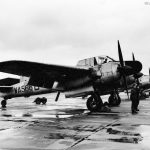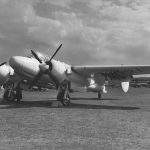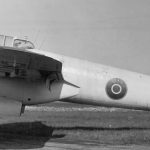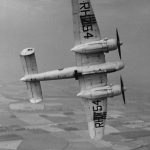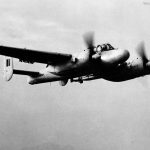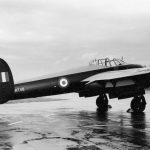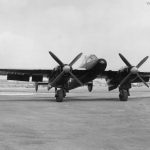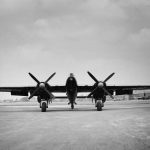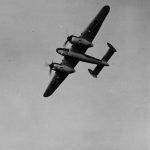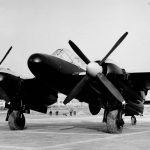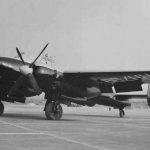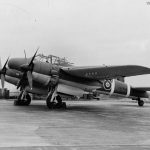Brigands 238 OCU make a final formation flight on 13 March 1958.
Brigands 238 OCU
Brigand T5 WA566 238 OCU Colerne
Brigand RH806 of No. 228 Operational Conversion Unit
Brigand RH806 2
Brigand T.5 238 OTU
Brigand RH798 October 1949
Brigand RH797 with torpedo under the centre fuselage.
Brigand RH761 in Coastal Command finish, 1947
Brigand RH754
Brigand RH754
Brigand RH754
Brigand RH754
Brigand RH748
Brigand RH748
Brigand RH742
First production Brigand RH742
Brigand RH742 with rockets
Brigand TF.Mk.1 RH742
Brigand MX988 1944
Brigand MET.3 VS819 1949
Brigand MET.3 VS819
Brigand MET.3 VS819
Brigand Mk 3 VS819
Brigand cockpit
Brigand 1945
Brigand 238 OCU
Brigand
Brigand 2
Bristol Brigand loaded with rockets and torpedo
Brigand in flight
Brigand TF1
Brigand RH798
Brigand RH746
Brigand Mk 3 VS814
The Prototype Brigand Mk 1 MX 994
Brigand Met Mk 3 rear view
The adaptation of the Beaufighter as a torpedo bomber, fighter was successful but yet was not as good as an aeroplane built for the job would have been. Consequently, in 1942, Bristol set out a design for a Hercules engined torpedo bomber along similar lines to the Beaufighter but with a high set tail plane and bubble canopy. The Ministry issued specification H7/42 and a full scale wooden mock up of the fuselage was built in the Experimental Shop in 1942.
After considering alternative ideas a new machine was devised by using the H7/42 fuselage married to Buckingham style wings and tail with 2,500hp Centaurus engines as prime movers.
The first prototype, MX988 was flown on 4 December 1944, with Centaurus VII engines, which were also installed in the three subsequent prototypes MX991 MX994 and TX374. After early handling tests Centaurus XVII’s were substituted and these in turn gave way to Centaurus 57’s with methanol-water injection on production aircraft. The Brigand was similar in construction to the Buckingham and finally assembled on the same jigs, but differed in detail apart from the fuselage shape. The tail unit was stronger and the wing centresection 152 mm wider, resulting in a similar increase in span. The Brigand had larger ailerons than the Buckingham, also Fairey-Youngman pneumatic dive-brakes operated from a venturi in the wing leading edge outboard of each engine, and the wing tips were of bonded wood, so as to act as dielectric fairings for the ASV transmitting antennae. The main undercarriage units were the same, but the Brigand had a Messier tail wheel, with spring emergency extension instead ofthe Turner unit ofthe Buckingham. The first 11 production Brigands RH742-RH752), were delivered as torpedo-fighters to Nos. 36 and 42 Squadrons and the Air/Sea Weapons Development Unit of RAF Coastal Command in 1946, but by that time the Air Staff requirement for a coastal strike aircraft was obsolescent and they were returned to Filton for conversion into light bombers for tropical duty in Burma and Malaya. This variant, Brigand B.Mk.I, retained the four cannon armament (with modified blast tubes) but not the rear gun. The cockpit enclosure was redesigned as a one-piece moulded transparency, giving an improved view and rapid hood jettisoning. Armour plate was retained and external bomb racks and rocket rails were fitted. The Met Mk 3 was an unarmed weather reconnaissance variant while the T Mk 4 radar trainer, also unarmed, featured an AI Mk X radar in the nose and black-out blinds for the trainee’s rear cockpit. The final version, which was converted from B Mk 1s and T Mk 4s, was the T Mk 5 radar trainer installed with an AI Mk 21 radar in a slightly longer nose.The T Mk 4 first flew in 1949 and entered service with 228 OCU at Leeming in July 1951. It was joined by the T Mk 5 from 1955 and, by the time of their retirement in 1958, the two aircraft had training approximately 600 radar navigators.
Serials
Prototypes: MX988, MX991 MX994 and TX374
Mk 1: RH742 – RH777, RH792-RH832, RH850-RH852, VS828-VS839, VS854-VS877, WA560, WB236
Mk 3: VS812-VS827
Mk 4: WA561-WA569
Source
C.H. BARNES: Bristol aircraft since 1910, Putnam
Martyn CHORLTON: Company Profile 1910-1959 Bristol
Geoff Green: Bristol Aerospace Since 1910





